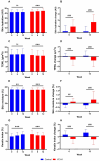Hibiscus Collagen Alternative (VC-H1) as an Oral Skin Rejuvenating Agent: A 12-Week Pilot Study
- PMID: 40806423
- PMCID: PMC12347160
- DOI: 10.3390/ijms26157291
Hibiscus Collagen Alternative (VC-H1) as an Oral Skin Rejuvenating Agent: A 12-Week Pilot Study
Abstract
Skin aging causes reduced hydration, elasticity, and increased wrinkles. Recent safety and compliance concerns over oral collagen supplements have increased interest in plant-based alternatives like Hibiscus sabdariffa with antioxidant and anti-aging properties. However, clinical evidence regarding its efficacy remains limited. We aimed to evaluate the effects of this plant-based collagen alternative (VC-H1, Hibiscus Enzyme Extract) supplement on skin hydration, transepidermal water loss (TEWL), desquamation, elasticity, and wrinkle reduction in photoaged individuals. A randomized, double-blind, placebo-controlled clinical trial was conducted with 98 participants (aged 35-60 years) presenting with dry skin and periorbital wrinkles. Participants randomly received 1.5 g/day of VC-H1 or placebo for 12 weeks. Skin hydration, TEWL, deep moisture, keratin index, elasticity, and wrinkle parameters were assessed at baseline, 6 weeks, and 12 weeks. VC-H1 supplementation significantly increased skin hydration, reduced the TEWL and keratin index, and improved deep moisture content for those receiving it compared with the controls. Wrinkle depth significantly decreased, and skin elasticity also improved. Those in the VC-H1 group showed greater overall improvement than those in the control group. Oral VC-H1 supplementation significantly improved skin hydration, elasticity, and wrinkle reduction, suggesting its potential as a plant-based alternative to traditional collagen supplements for skin rejuvenation.
Keywords: Hibiscus sabdariffa; elasticity improvement; plant-based collagen; skin hydration; skin rejuvenation; wrinkle reduction.
Conflict of interest statement
Author Min Joo Jung and In Ah Kim were employed by Global Medical Research Center. Author Sung Jun Lee was employed by Liting Plastic Surgery, and author Hyun Min Kim was employed by Rawga Inc. The remaining authors declare that the research was conducted in the absence of any commercial or financial relationships that could be construed as a potential conflict of interest.
Figures







Similar articles
-
Clinical Trial of Salmon Nasal Cartilage-Derived Proteoglycans on Human Facial Antiaging: A Randomized, Double-Blind, Placebo-Controlled Study.J Cosmet Dermatol. 2025 Jul;24(7):e70218. doi: 10.1111/jocd.70218. J Cosmet Dermatol. 2025. PMID: 40613544 Free PMC article. Clinical Trial.
-
Tolerability and efficacy assessment of an oral collagen supplement for the improvement of biophysical and ultrasonographic parameters of skin in middle eastern consumers.J Cosmet Dermatol. 2023 Aug;22(8):2252-2258. doi: 10.1111/jocd.15700. Epub 2023 Mar 13. J Cosmet Dermatol. 2023. PMID: 36912494
-
Effects of hydrolyzed collagen supplementation on skin aging: a systematic review and meta-analysis.Int J Dermatol. 2021 Dec;60(12):1449-1461. doi: 10.1111/ijd.15518. Epub 2021 Mar 20. Int J Dermatol. 2021. PMID: 33742704
-
The Effects of an Oral Supplementation of a Natural Keratin Hydrolysate on Skin Aging: A Randomized, Double-Blind, Placebo-Controlled Clinical Study in Healthy Women.J Cosmet Dermatol. 2025 Jan;24(1):e16626. doi: 10.1111/jocd.16626. Epub 2024 Oct 4. J Cosmet Dermatol. 2025. PMID: 39367631 Free PMC article. Clinical Trial.
-
Efficacy and Safety of Topical Application of Plant-Based Products on Skin Aging in Healthy Individuals: A Systematic Review and Meta-Analysis of Randomized Controlled Trials.J Cosmet Dermatol. 2025 Feb;24(2):e16710. doi: 10.1111/jocd.16710. Epub 2024 Dec 9. J Cosmet Dermatol. 2025. PMID: 39654386 Free PMC article.
References
Publication types
MeSH terms
Substances
LinkOut - more resources
Full Text Sources
Medical

